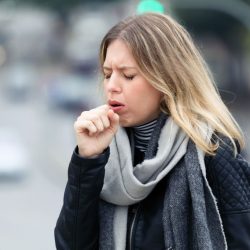Conjunctivitis is an inflammation of the conjunctiva (a transparent membrane lining the white of the eye and the inside of the eyelids, which secretes mucus). Due to the highly exposed position of this protective membrane, the forms of conjunctivitis are particularly numerous . Conjunctivitis can, however, be of viral, bacterial, allergic or even irritative origin.
What are the different types of existing conjunctivitis?
Actinic conjunctivitis:
Also known as snow ophthalmia , it results from unprotected exposure of the eyes to solar UV rays and results in acute inflammation of the conjunctiva and underlying cornea .
Allergic conjunctivitis:
Allergic conjunctivitis is an acute, intermittent or even chronic illness per year usually caused by environmental allergens. Symptoms include pruritus , tearing , discharge and conjunctival hyperemia .
-
Seasonal allergic conjunctivitis (hay fever conjunctivitis):
It is caused by mold spores, or pollen from trees, grasses or weeds carried by the air. It experiences an upsurge in spring , at the end of summer or at the beginning of autumn and tends to disappear during the winter months, which corresponds in fact to the evolutionary cycle of the responsible plant.
-
Permanent allergic conjunctivitis (atopic conjunctivitis, atopic keratoconjunctivitis):
It is caused by dust mites, house dust, dander, pets and other non-seasonal allergens . These allergens, in particular those which are in the house, induce a symptomatology per year .
-
Spring keratoconjunctivitis:
It represents the most severe type of conjunctivitis and its allergic origin is possible. It mainly affects boys aged 5 to 20 who also have eczema, asthma or seasonal allergies . Vernal keratoconjunctivitis usually reappears every spring and gets better in the fall and winter. Many children recover in adulthood.
The catarrhal conjunctiva:
It accompanies the common cold or coryza, the hay fever as well as the flu .
Viral conjunctivitis:
Viral conjunctivitis is a highly contagious , acute infection usually caused by an adenovirus. Symptoms therefore include irritation, photophobia and watery discharge. Sometimes viral cultures or immunological diagnostic tests are indeed indicated. The infection is therefore generally self-limiting .
Adult inclusion conjunctivitis:
Inclusion conjunctivitis in adults is also caused by the sexual transmission of Chlamydia trachomatis . Symptoms also include chronic unilateral hyperemia and mucopurulent discharge.
Neonatal conjunctivitis:
Neonatal conjunctivitis is a watery or purulent discharge from the eye due to an irritating chemical agent or a pathogenic microorganism . Prevention by topical anti-gonococcal treatment at birth is also systematic.
-
Chemical conjunctivitis:
Secondary to topical prophylaxis , it usually appears within 6 to 8 hours of instillation and resolves spontaneously within 48 to 96 hours.
-
Chlamydial conjunctivitis :
It usually occurs 5 to 14 days after birth. The clinical picture can then range from moderate conjunctivitis with mucopurulent discharge to edema with heavy discharge and formation of pseudomembranes. There are no follicles on the conjunctiva, unlike in older children or adults.
-
Gonococcal ophthalmia:
It is an acute purulent conjunctivitis which appears 2 to 5 days after birth, but which can begin earlier in the event of premature rupture of the membranes . The newborn indeed presents a significant eyelid edema followed by the appearance of chemosis and an abundant purulent discharge which may be under pressure. If left untreated, corneal ulcers and blindness can occur, however .
Acute bacterial conjunctivitis:
Bacterial conjunctivitis can therefore be caused by many bacteria . Symptoms are hyperemia, tearing, irritation and discharge. Treatment is based on topical antibiotics, combined with general antibiotics, in the most serious cases.
Most of the time, bacterial conjunctivitis is caused by Staphylococcus aureus , Streptococcus pneumoniae , Haemophilus spp , Moraxella catarrhalis or more rarely Chlamydia trachomatis . Neisseria gonorrhoeae , additionally causes gonococcal conjunctivitis, which is usually due to sexual contact with a patient with genital infection.
Some natural tips to relieve the discomfort caused by conjunctivitis
- Always start by cleaning your eyes several times a day with physiological saline or with an antiseptic cleaning solution. It is the basic natural treatment for conjunctivitis. If your child or baby has conjunctivitis, use the same treatment. And even if there is only one affected eye, always wash both eyes to avoid contamination from one eye to the other.
- Do not wear your contact lenses until the conjunctivitis has healed.
- Wash your hands regularly and before each use of eye drops.
- Observe the duration of treatment for your conjunctivitis recommended by the doctor.
- Eye drops, however, expire quickly: do not keep them.
Prevention tips:
- Avoid air conditioning towards the eyes.
- Wear swimming goggles or masks, especially when looking underwater.
- Daily cleanse the eyes of infants with physiological serum.
- Maintain contact lenses properly.
- Do not touch the eyes with dirty hands.
- Use hypoallergenic makeup.
Which homeopathic medicines to choose to relieve conjunctivitis?
To be taken systematically during conjunctivitis:
- Euphrasia officinalis 9CH : In case of burning eye discharge, watery nasal discharge, abundant but not irritating.
Dosage : 5 granules every 2 hours until symptoms improve.
- Apis mellifica 15CH : In case of stinging, burning eyelid edema, improved by cold.
Dosage : 5 granules every 2 hours until symptoms improve.
Allergic conjunctivitis:
Dosage : 5 granules morning and evening in a healthy mouth.
Dosage : No more than 6 lozenges per day. Do not exceed one week of treatment.
Bacterial conjunctivitis:
- Pyrogenium 9CH : Natural antibiotic.
Dosage : 5 granules 3 times a day.
Medical bibliographic sources and clinical trials :
- Unsal, AIA, Kocaturk, T., Gunel, C. et al. Effect of Pycnogenol® on an experimental rat model of allergic conjunctivitis. Graefes Arch Clin Exp Ophthalmol, 2018
- Mathie RT, Lloyd SM, Legg LA, et al. Randomized placebo-controlled trials of individualized homeopathic treatment: systematic review and meta-analysis. Syst Rev. 2014
- Mathie RT, Ramparsad N, Legg LA, et al. Randomized, double-blind, placebo-controlled trials of non-individualized homeopathic treatment: systematic review and meta-analysis. Syst Rev. 2017
- Mathie RT, Ulbrich-Zürni S, Viksveen P, et al. Systematic Review and Meta-Analysis of Randomized, Other-than-Placebo Controlled, Trials of Individualized Homeopathic Treatment. Homeopathy. 2018
- Mathie RT, Fok YYY, Viksveen P, To AKL, Davidson JRT. Systematic Review and Meta-Analysis of Randomized, Other-than-Placebo Controlled, Trials of Non-Individualized Homeopathic Treatment. Homeopathy. 2019






